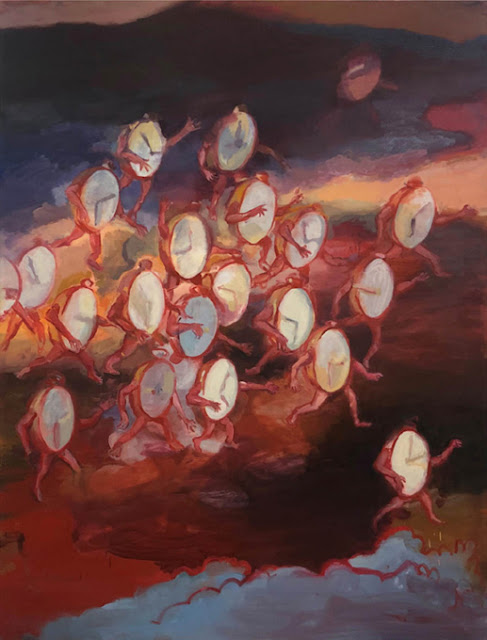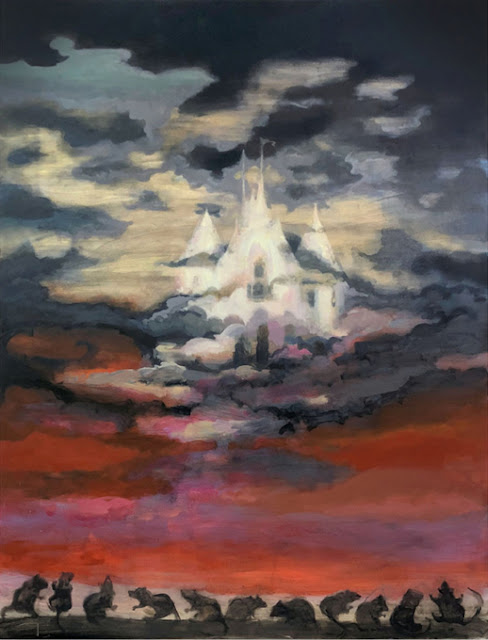NICHOLAS IVES - 'Sunset Roads'
Marfa Gallery 19th-28th March* 2020
Faced with dwindling commercial galleries around Melbourne, it is reassuring to discover another artist run initiative, particularly one as well appointed as Marfa.
Installation view
Administered by Black Art Projects, now in its tenth year and operating across various venues, the current show unfortunately coincides with the onset of a global pandemic and strict public safety measures mean the show at the time of writing has an uncertain duration*. It may be the show will only be accessed online and hopefully this review will prompt that much at least, but in any case it deserves a review.
The artist has an impressive record exhibiting in smaller spaces around Melbourne and elsewhere, stretching back to 2005 when he completed a master of fine arts at Monash University, where he now teaches. In the last ten years or so the work has steadily developed along Post Modernist lines, dealing in portraits of troubled, vaguely sinister archetypes, utopian architecture and design, popular myths and clichés. All are treated to spare, vigorous brushwork that gives the work a distinctive engagement and insouciance.
The artist has an impressive record exhibiting in smaller spaces around Melbourne and elsewhere, stretching back to 2005 when he completed a master of fine arts at Monash University, where he now teaches. In the last ten years or so the work has steadily developed along Post Modernist lines, dealing in portraits of troubled, vaguely sinister archetypes, utopian architecture and design, popular myths and clichés. All are treated to spare, vigorous brushwork that gives the work a distinctive engagement and insouciance.
Mirror Magic (2020) 198 X 152 cm oil on canvas
The show consists of fourteen mostly large oil paintings on canvas and finds the artist returning to a darker palette and sardonic tone, while notably leaving figures up in the air, scattered and scorned. The greater scale unquestionably announces a new confidence and scope and prompts reflections, for this reviewer at least, on the state of painting generally. These influenced the choice of a review to some extent and will be shared in closing but firstly there is the matter of Sunset Roads. In recent work the artist has increasingly devoted attention to figures in an array of stock costumes and poses that leave settings remote or abstracted; that effectively announce roles or characters in a vacuum. This aspect is expanded quite literally in Sunset Roads, to give us clichéd allegories and myths that occur in generous expanses of, at best, sky. They are part cartoon characters, part children’s story or game characters, at times, part Romantic clichés, such as Youth in a Wig (2019) where crucially the emphasis lies on disguise, even amongst saccharine sentiment.
Youth In a Wig (2019) 76 X 56 cm oil on canvas
New to the work and revelling in the scale are flying formations either of figures or playful allegorical characters such as the clocks in Pink Floyd (2020) violins in The Rapture (2020) and bluebirds in Release Me (2020). The titles, as with the show title, all play upon skewed popular culture, upon glancing or obscure allusion. Significantly, these groups too are airborne, ungrounded by any firmer reference, a fleeting squadron of symbols in search of a solid situation. The tension between mythic characters and their lack of apparent engagement or situation is in part what animates the brushwork, gives the work a vivacity rarely matched by fellow Post Modernists, where drawing and a markedly linear approach are usually foremost. For Ives, confusions of character, context and composition are all swept up in the flow of brushwork and give the work a striking immediacy.
Pink Floyd (2020) 198 X 152 cm oil on canvas
Equally, mood seesaws between comic and tragic, amused at the waywardness of reference yet concerned that reference must nevertheless be maintained. This dilemma also finds its parallel in the peremptory brushwork, never entirely convinced of the need for greater detail or finish, uncertain how broad or sweeping to then allow gesture. The result can give the work a troubling ambivalence. The artist’s catalogue note acknowledges ‘loss’ as a pervasive mood, a failure to properly transcend its clichéd metaphors perhaps, an unrecovered faith in greater abstraction, possibly, or the reliance upon purely personal resources, something that is also hinted at in the note. At any rate the darker palette paces a darker mood, one that merry flying formations never quite lift.
Scooby Doo (2020) 179 X 137 cm oil on canvas
Trapdoor (2020) 198 X 152 cm oil on canvas
In conversation the artist also stressed the importance of a sense of disruption or intervention within a painting, a need to resist the urge to great consistency or coherence. This too is a familiar Post Modernist stance, a plea for incompleteness, variously formulated, but often advanced as rationale for the use of collage. In Ives’ case this displays less as a compositional stratagem than – again - the restless brushwork, unhappy with its level of illustration, uncertain of its gestural clichés beyond that. The work proceeds, as the artist notes in the catalogue, on ‘a knife-edge’. Given the scale to many of the works, details to brushwork or facture hardly register in a reproduction of the whole work so it is helpful to consider a detail, given the importance attached here to the artist’s technique.
Detail to Trapdoor (2020)
Notice the works are not always heavily worked and that in areas paint may be wiped or rubbed off, adding to the inconstancy or wavering within technique. Much of the charm to the work lies in its surprising delicacy of touch, even amid blunt summations and gesture. Similarly, while most works are dated 2020, their genesis tends to run to months of intermittent revisions rather than days or weeks. The work wears its labours lightly. If there are weaknesses to the approach, they perhaps lie with lesser works such as The Illusion (Rat Sees The Light) (2020) or The Shadow (Rat in a Cave) (2020), where rendering is more straightforward and there is less room for oscillations and conspicuous revision.
The Illusion (Rat Sees The Light) (2020) 57 X 47 cm oil on canvas
Of course the question soon arises why such elementary roles are pursued in the first place, if their use proves so nebulous? The answer brings us to some more general closing remarks. It would seem to lie in their simplified, foundational appeal. Like the masks and costumes of ‘Carnivalesque’ painters from Germans such as Neo Rauch or Jonas Burgert, to Britons such as Later Doig or Ryan Moseley, to local advocate Michael Vale (a Monash staff associate of Ives) the appeal is really to very strict or simplified roles, a pantomime or play at engagement. The aim in such works is surely to claim a limited scope to roles, even when roles proliferate or opportunities are plainly absurd. The interest in this kind of agency might usefully be seen as complement to the dominant trend to Identity Art – to the person constructed as stereotype for race, colour, gender or creed.
The Danse (2020) 198 X 152 cm oil on canvas
This has become such an important plank for art institutions it is sometimes difficult to see alternatives. Identity Art largely pursues the local or regional at the expense of the national or universal, but pointedly resists the individual. For artists like Ives, such identities are as inadequate as fairytale characters or comic strips. They are the antithesis of Identity artists, instead appealing to the global (not quite universal) over the national, to common mythology and multiple roles for the person, especially abroad or out of their comfort zone.
Vampyre (2020) 57 X 47 cm oil on canvas
This distinction does not coincide with Post Modernism, advocates for either may lie within or without, indeed some artists work may straddle the distinction, but the disputed territory is firmly between the local and general, a shared heritage against a closed or privileged one. Traditional individualism is shunned by both. For Identity artists, it is exchanged for a lifestyle or sub-culture, for opponents – let us call them ‘Carnivalesque’ here – individuality is replaced with multiple minor roles, for a host of familiar myths with which to engineer greater scope.
This distinction has yet to be recognised by curators or state-funded institutions since it runs counter to deeply entrenched politics. For this reason it is not that surprising to find a show like Sunset Roads in a largely neglected venue. Both trends may use pastiche or parody of historical works, but crucially the Carnivalesque artist has more formal options, since they allow multiple received sources and this has important consequences for painting. While there is little stomach anymore for formulating absolutes for painting - any more than individuals for persons - the Carnivalesque project of multiple, partial roles brings with it a new interest in the latitude allowed iconography, the content permitted style. Painting finds surprising resources in this relaxation to the figure.
These remarks are obviously speculative and intended as provocation. At a point where the art world seems hopeless sidelined and stagnant, broader debate is sorely needed.











